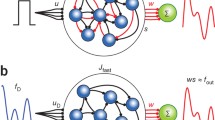Abstract
Notable advances in the understanding of neural processing were made when sensory systems were investigated from the viewpoint of adaptation to the statistical structure of their input space. For this purpose, mathematical methods for data representation were used. Here, we point out that emphasis on the input structure has been at the cost of the biological plausibility of the corresponding neuron models which process the natural stimuli. The signal transformation of the data representation methods does not correspond well to the signal transformations happening at the single-cell level in neural systems. Hence, we now propose data representation by means of spiking neuron models. We formulate the data representation problem as an optimization problem and derive the fundamental quantities for an iterative learning scheme.
Similar content being viewed by others
References
Barlow HB (1961) Possible principles underlying the transformations of sensory messages. In: Rosenblith W (ed) Sensory communication. MIT Press, Cambridge, pp 217–234
Dong D, Atick J (1995) Statistics of natural time-varying images. Network Comp Neural Syst 6:345–358
Frazor RA, Geisler WS (2006) Local luminance and contrast in natural images. Vision Res 46:1585–1598
Ruderman D (1994) The statistics of natural images. Network Comp Neural Syst 5:517–548
Hyvärinen A, Hoyer PO, Hurri J, et al. (2005) Statistical models of images and early vision. In: Honkela T, Könönen V, Pöllä M, Simula O (eds) Proceedings of AKRR 05, International and Interdisciplinary Conference on Adaptive Knowledge Representation and Reasoning, Espoo, Finland, Jun. 2005, pp 1–14
Simoncelli EP, Olshausen BA (2001) Natural image statistics and neural representation. Anna Rev Neurosci 24:1193–1216
Vincent B, Baddeley R, Troscianko T, et al. (2005) Is the early visual system optimised to be energy-efficient? Network Comp Neural Syst 16:175–190
Graham DJ, Chandler DM, Field DJ (2006) Can the theory of “whitening” explain the center-surround properties of retinal ganglion cell receptive fields? Vision Res 46:2901–2913
Rieke F, Warland D, van Steveninck R de R, et al. (1997) Spikes: exploring the neural code. MIT Press, Cambridge
Gerstner W, Kistler WK (2002) Spiking neuron models. Cambridge University Press, Cambridge
Gelfand IM, Fomin SV (2000) Calculus of variations. Dover, New York
Author information
Authors and Affiliations
Corresponding author
About this article
Cite this article
Gutmann, M., Aihara, K. Toward data representation with spiking neurons. Artif Life Robotics 12, 223–226 (2008). https://doi.org/10.1007/s10015-007-0471-7
Received:
Accepted:
Published:
Issue Date:
DOI: https://doi.org/10.1007/s10015-007-0471-7




